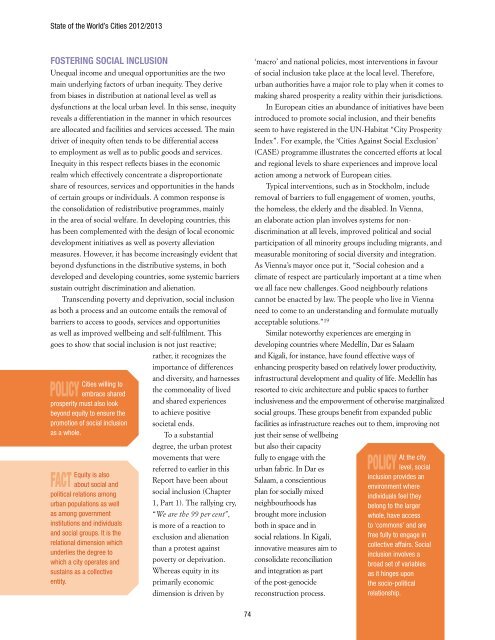state of the world's cities 2012/2013 - United Nations Sustainable ...
state of the world's cities 2012/2013 - United Nations Sustainable ...
state of the world's cities 2012/2013 - United Nations Sustainable ...
You also want an ePaper? Increase the reach of your titles
YUMPU automatically turns print PDFs into web optimized ePapers that Google loves.
State <strong>of</strong> <strong>the</strong> World’s Cities <strong>2012</strong>/<strong>2013</strong>Fostering Social InclusionUnequal income and unequal opportunities are <strong>the</strong> twomain underlying factors <strong>of</strong> urban inequity. They derivefrom biases in distribution at national level as well asdysfunctions at <strong>the</strong> local urban level. In this sense, inequityreveals a differentiation in <strong>the</strong> manner in which resourcesare allocated and facilities and services accessed. The maindriver <strong>of</strong> inequity <strong>of</strong>ten tends to be differential accessto employment as well as to public goods and services.Inequity in this respect reflects biases in <strong>the</strong> economicrealm which effectively concentrate a disproportionateshare <strong>of</strong> resources, services and opportunities in <strong>the</strong> hands<strong>of</strong> certain groups or individuals. A common response is<strong>the</strong> consolidation <strong>of</strong> redistributive programmes, mainlyin <strong>the</strong> area <strong>of</strong> social welfare. In developing countries, thishas been complemented with <strong>the</strong> design <strong>of</strong> local economicdevelopment initiatives as well as poverty alleviationmeasures. However, it has become increasingly evident thatbeyond dysfunctions in <strong>the</strong> distributive systems, in bothdeveloped and developing countries, some systemic barrierssustain outright discrimination and alienation.Transcending poverty and deprivation, social inclusionas both a process and an outcome entails <strong>the</strong> removal <strong>of</strong>barriers to access to goods, services and opportunitiesas well as improved wellbeing and self-fulfilment. Thisgoes to show that social inclusion is not just reactive;ra<strong>the</strong>r, it recognizes <strong>the</strong>importance <strong>of</strong> differencesand diversity, and harnessesCities willing to<strong>the</strong> commonality <strong>of</strong> livedpolicy embrace sharedprosperity must also look and shared experiencesbeyond equity to ensure <strong>the</strong> to achieve positivepromotion <strong>of</strong> social inclusion societal ends.as a whole.To a substantialdegree, <strong>the</strong> urban protestmovements that werereferred to earlier in thisEquity is alsoReport have been aboutfact about social andpolitical relations among social inclusion (Chapterurban populations as well 1, Part 1). The rallying cry,as among government“We are <strong>the</strong> 99 per cent”,institutions and individuals is more <strong>of</strong> a reaction toand social groups. It is <strong>the</strong>exclusion and alienationrelational dimension whichthan a protest againstunderlies <strong>the</strong> degree towhich a city operates and poverty or deprivation.sustains as a collectiveWhereas equity in itsentity.primarily economicdimension is driven by‘macro’ and national policies, most interventions in favour<strong>of</strong> social inclusion take place at <strong>the</strong> local level. Therefore,urban authorities have a major role to play when it comes tomaking shared prosperity a reality within <strong>the</strong>ir jurisdictions.In European <strong>cities</strong> an abundance <strong>of</strong> initiatives have beenintroduced to promote social inclusion, and <strong>the</strong>ir benefitsseem to have registered in <strong>the</strong> UN-Habitat “City ProsperityIndex”. For example, <strong>the</strong> ‘Cities Against Social Exclusion’(CASE) programme illustrates <strong>the</strong> concerted efforts at localand regional levels to share experiences and improve localaction among a network <strong>of</strong> European <strong>cities</strong>.Typical interventions, such as in Stockholm, includeremoval <strong>of</strong> barriers to full engagement <strong>of</strong> women, youths,<strong>the</strong> homeless, <strong>the</strong> elderly and <strong>the</strong> disabled. In Vienna,an elaborate action plan involves systems for nondiscriminationat all levels, improved political and socialparticipation <strong>of</strong> all minority groups including migrants, andmeasurable monitoring <strong>of</strong> social diversity and integration.As Vienna’s mayor once put it, “Social cohesion and aclimate <strong>of</strong> respect are particularly important at a time whenwe all face new challenges. Good neighbourly relationscannot be enacted by law. The people who live in Viennaneed to come to an understanding and formulate mutuallyacceptable solutions.” 19Similar noteworthy experiences are emerging indeveloping countries where Medellín, Dar es Salaamand Kigali, for instance, have found effective ways <strong>of</strong>enhancing prosperity based on relatively lower productivity,infrastructural development and quality <strong>of</strong> life. Medellín hasresorted to civic architecture and public spaces to fur<strong>the</strong>rinclusiveness and <strong>the</strong> empowerment <strong>of</strong> o<strong>the</strong>rwise marginalizedsocial groups. These groups benefit from expanded publicfacilities as infrastructure reaches out to <strong>the</strong>m, improving notjust <strong>the</strong>ir sense <strong>of</strong> wellbeingbut also <strong>the</strong>ir capacityfully to engage with <strong>the</strong>At <strong>the</strong> cityurban fabric. In Dar es policy level, socialSalaam, a conscientiousinclusion provides anenvironment whereplan for socially mixedindividuals feel <strong>the</strong>yneighbourhoods hasbelong to <strong>the</strong> largerbrought more inclusionwhole, have accessboth in space and into ‘commons’ and aresocial relations. In Kigali,free fully to engage ininnovative measures aim tocollective affairs. Socialinclusion involves aconsolidate reconciliationbroad set <strong>of</strong> variablesand integration as partas it hinges upon<strong>of</strong> <strong>the</strong> post-genocide<strong>the</strong> socio-politicalreconstruction process.relationship.74





